#sicyos angulatus
Photo
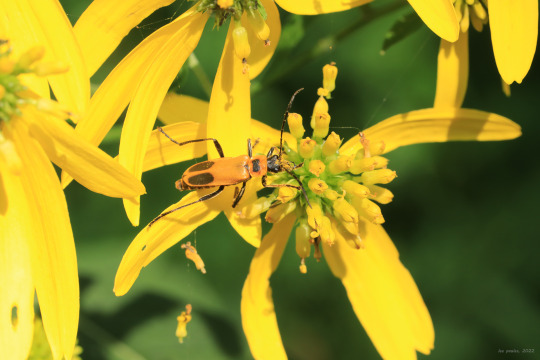
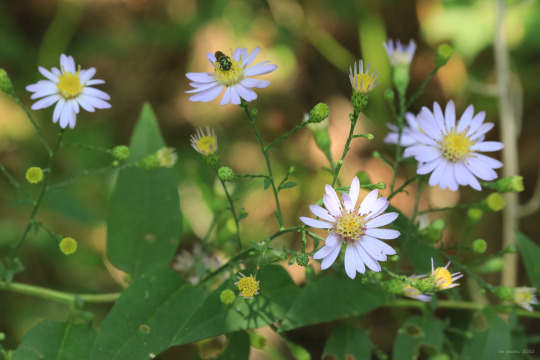

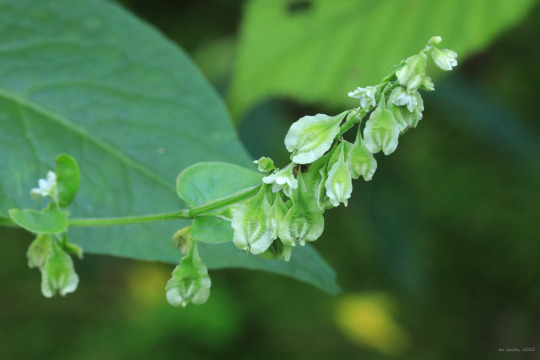

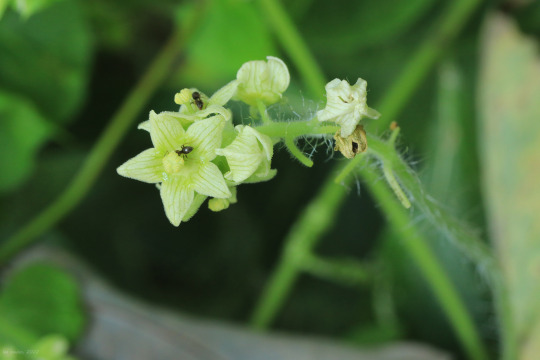




A few late summer odds and ends from a bike ride on the Mon River Trail yesterday. The asters are really starting to pop now as the days grow noticeably shorter and autumn closes in. A number of interesting vines are also in bloom and producing fruit for wildlife before the first frost. Climbing false buckwheat (Fallopia scandens) and oneseed bur cucumber (Sicyos angulatus), a member of the gourd family, are both aggressive twining vines with distinctive foliage, flowers, and fruits.
From top: a goldenrod soldier beetle strikes nectar gold on a wingstem flower (Verbesina alternifolia); Short’s aster (Symphyotrichum shortii), a really beautiful perennial often found growing in dry to mesic oak-hickory woods with limestone near the surface; climbing false buckwheat, a delicate twiner whose pendulous fruit has three ruffled sides, like pantaloons; oneseed bur cucumber, whose bristly fruit can cause painful stings; crooked-stemmed aster (Symphyotrichum prenanthoides), also known as zag-zag aster, whose stems often zig-zag between the nodes of its spatula-shaped leaves; and the glorious New England aster (Symphyotrichum novae-angliae), one of the most important pollinator plants of late summer and early autumn.
#appalachia#vandalia#west virginia#late summer#flora#wildflowers#mon river trail#verbesina alternifolia#wingstem#symphyotrichum shortii#short's aster#fallopia scandens#climbing false buckwheat#sicyos angulatus#oneseed bur cucumber#bur cucumber#symphyotrichum prenanthoides#crooked-stemmed aster#crooked-stem aster#zig-zag aster#symphyotrichum novae-angliae#new england aster
41 notes
·
View notes
Photo
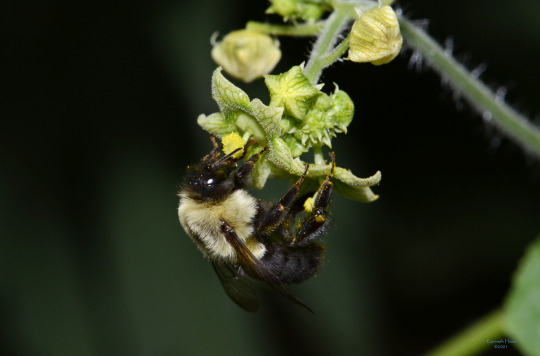
Bur Cucumber
The peculiar flower of the Bur Cucumber (Sicyos angulatus) attracts pollinators with an abundant supply of pollen. This Common Eastern Bumble Bee moved from blossom to blossom collecting the golden powder.
43 notes
·
View notes
Photo
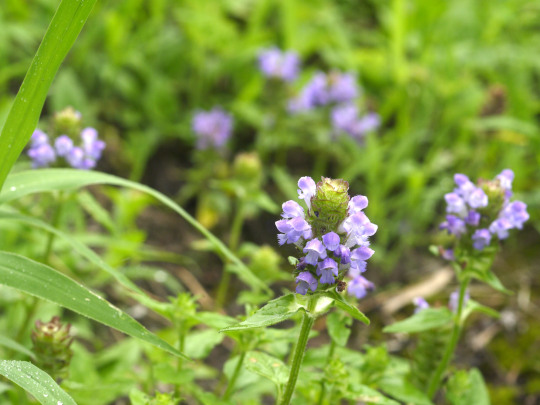
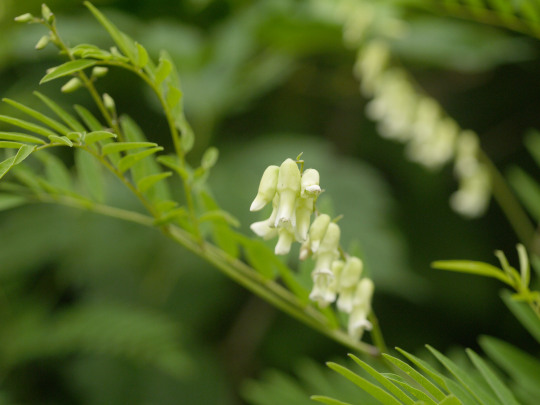

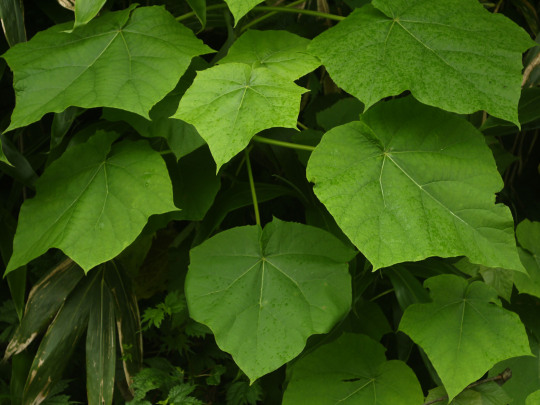
7月初旬の里山 Those in local hills in early July.
ウツボグサ/クララ/アカショウマ/アレチウリの葉(特定外来生物)
Prunella vulgaris subsp. asiatica / Sophora flavescens / Astilbe thunbergii var. thunbergii / Sicyos angulatus (North American origin)
#nature#wildflowers#juky#niigata#japan#original photography on tumblr#photographers on tumblr#smc macro takumar 50mm/f4#ウツボグサ#クララ#アカショウマ#アレチウリ#特定外来生物
26 notes
·
View notes
Text

アレチウリ (荒れ地瓜, oneseed bur cucumber, star-cucumber, ウリ科, :: Sicyos angulatus L. ). 北米原産.
1 note
·
View note
Photo
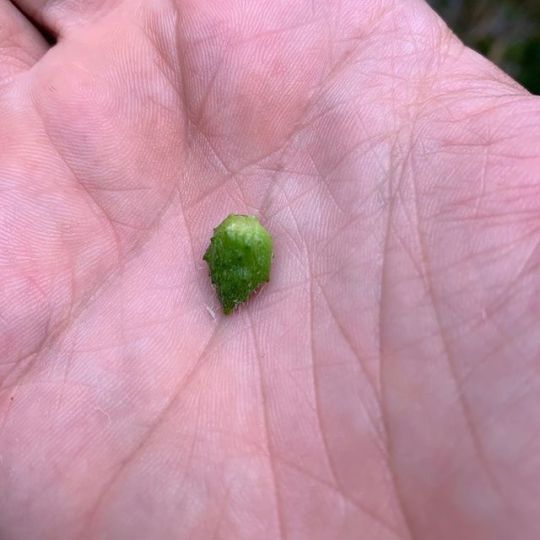
Burr cucumber (Sicyos angulatus). Lots of people don’t realize that tiny wild cucumbers grow out in the woods. The plant looks a lot like a garden cucumber vine, and the fruit is a little cluster of caper-sized cucmbers. I’m going to pickle small jar of them. . . . Besides the esible fruit, the vine is used medicinally to increase movement of fluids in the body, and the foliage can be eaten after the bitterness is bouled out of it. . . . . #herbalmedicine #wildfood #huntergatherer #herbalism #foraging #weeds https://www.instagram.com/p/B2c4Ekolmtn/?igshid=uv3bztabylg7
11 notes
·
View notes
Photo



Oneseed bur cucumber or star-cucumber (Sicyos angulatus) is an annual vine in the gourd family, Cucurbitaceae, native to eastern North America. The plant forms mats or climbs using tendrils. The leaves are palmately veined and lobed, the flowers are green to yellowish green, and the fruits form clusters of very small pepos. Bumblebees and honey bees, as well as various flies, sphecid wasps and vespid wasps are attracted to the nectar produced by the flowers.
40 notes
·
View notes
Link
For just $4.24 Please use dropdown box to order ! bur cucumber, any of several tropical climbing plants in the genus Sicyos, of the gourd family (Cucurbitaceae). One species (S. angulatus), known also as star cucumber, is native to North America. A bur cucumber has sharply lobed leaves, forked tendrils, clusters of five-petaled white flowers that are borne at the ends of long stalks that arise from the leaf axils, and clusters of oval, prickly, single-seeded fruits. Herb: Bur Cucumber Latin name: Sicyos angulatus Family: Cucurbitaceae (Cucumber Family, Gourd Family) Medicinal use of Bur Cucumber: A decoction of the vine has been used in the treatment of venereal disease. Genus Sicyos Species Angulatus Common name Bur Cucumber Other Names Oneseed Bur Cucumber Pre-Treatment Not-required Hardiness zones 3 - 8 Height 25'-30'/7.6m - 9.1m Plant type Annual vine Vegetation type Deciduous Exposure Full Sun, Partial Sun Growth rate Fast Soil PH Acidic, Neutral, Alkaline Soil type Loam, fertile, well drained Water requirements Average, Wet Landscape uses Quick growing wine with naturalistic look Germination rate 80% Bloom season Summer Leaf/Flower color Green/Green to yellowish Habitat of the herb: River banks and damp yards. Edible parts of Bur Cucumber: Leaves - cooked. They can be cooked as greens. The fruit is said to be edible. Possibly the seed is edible but there is no flesh on the fruit, it is just a bristly skin around the seed. The fruit is about 1cm long and is borne in small clusters. Propagation of the herb: Seed - sow in mid spring in a greenhouse. Germination should take place within 2 weeks. Prick out the seedlings into individual pots once they are large enough to handle. Make sure the compost is fairly rich and grow the plants fast. Plant them out after the last expected frosts and consider giving them some protection such as a cloche until they are growing away actively. The seed can also be sown in situ in late spring, though this sowing might not ...
0 notes
Text
Range expansion potential of two co-occurring invasive vines to marginal habitats in Turkey
Publication date: October 2017
Source:Acta Oecologica, Volume 84
Author(s): Shahid Farooq, Sonnur Tad, Huseyin Onen, Hikmet Gunal, Ugur Caldiran, Cumali Ozaslan
Niche distribution models accurately predict the potential distribution range of invasive plants into new habitats based on their climatic requirements in the native regions. However, these models usually ignore the marginal habitats which can limit the distribution of exotic plants. We therefore tested the seedling survival, growth and nutrient acquisition capabilities of two co-occurring invasive vines [Persicaria perfoliata (L.) H. Gross and Sicyos angulatus L.] in three different manipulative greenhouse experiments to infer their range expansion potential to marginal habitats in Turkey. First experiment included five different moisture availability regimes (100, 75, 50, 25 and 12.5% available water), second experiment consisted of four different salinity levels (0, 3, 6 and 12 dSm−1 soil salinity) and third experiment had four different soil textures (clay-1, clay-2, sandy loam and silt-clay-loam). Seedling mortality was only observed under extreme moisture deficiency in both plant species, while most of the transplanted seedlings of both species did not survive under 6 and 12 dSm−1 salinity levels. Soil textures had no effect on seedling survival. POLPE better tolerated low moisture availability and high salinity compared to SIYAN. Biomass production in both plant species was linearly reduced with increasing salinity and moisture deficiency. SIYAN invested more resources towards shoot, accumulated higher K and P, whereas POLPE maintained higher root-to-shoot ratio under all experimental conditions. Both plant species employed different strategies to cope with adverse environmental conditions, but failed to persist under high soil salinity and moisture deficiency. Our study suggest that both plant species have limited potential of range expansion to marginal habitats and will be limited to moist and humid areas only. Therefore, further research activities should be concentrated in these regions to develop effective management strategies against both species.
from # All Medicine by Alexandros G. Sfakianakis via alkiviadis.1961 on Inoreader http://ift.tt/2xwzOCW
from OtoRhinoLaryngology - Alexandros G. Sfakianakis via Alexandros G.Sfakianakis on Inoreader http://ift.tt/2xwwIPz
0 notes
Photo

Star-cucumber (Sicyos angulatus). Plate from 'The Native Flowers and Ferns of the United States in Their Botanical, Horticultural and Popular Aspects' by Thomas Meehan.
Published 1880 by American National History Publishing Co.
archive.org
#botany#botanical#botanical illustration#star-cucumber#Sicyos angulatus#plant#leaves#Thomas Meehan#1880
39 notes
·
View notes
Photo

Late summer reveals the Bur Cucumber (Sicyos angulatus) is a reliable source of pollen for a variety of bees, including the Honey Bee (Apis mellifera).
55 notes
·
View notes
Photo
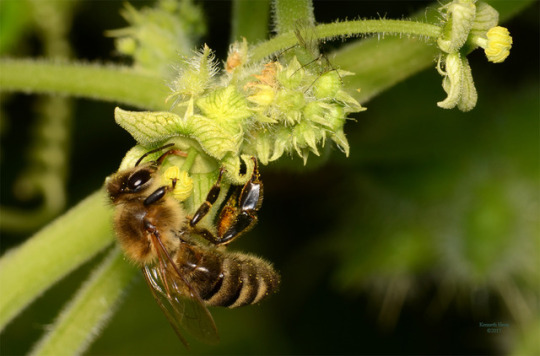
A dark Honey Bee (Apis mellifera) gathers nectar from a male flower of a Bur Cucumber (Sicyos angulatus) plant. This plant attracts many bumble bees as well as honey bees, flies and wasps for the nectar it provides. The female flowers are between the male flowers.
82 notes
·
View notes
Text
Range expansion potential of two co-occurring invasive vines to marginal habitats in Turkey
Publication date: October 2017
Source:Acta Oecologica, Volume 84
Author(s): Shahid Farooq, Sonnur Tad, Huseyin Onen, Hikmet Gunal, Ugur Caldiran, Cumali Ozaslan
Niche distribution models accurately predict the potential distribution range of invasive plants into new habitats based on their climatic requirements in the native regions. However, these models usually ignore the marginal habitats which can limit the distribution of exotic plants. We therefore tested the seedling survival, growth and nutrient acquisition capabilities of two co-occurring invasive vines [Persicaria perfoliata (L.) H. Gross and Sicyos angulatus L.] in three different manipulative greenhouse experiments to infer their range expansion potential to marginal habitats in Turkey. First experiment included five different moisture availability regimes (100, 75, 50, 25 and 12.5% available water), second experiment consisted of four different salinity levels (0, 3, 6 and 12 dSm−1 soil salinity) and third experiment had four different soil textures (clay-1, clay-2, sandy loam and silt-clay-loam). Seedling mortality was only observed under extreme moisture deficiency in both plant species, while most of the transplanted seedlings of both species did not survive under 6 and 12 dSm−1 salinity levels. Soil textures had no effect on seedling survival. POLPE better tolerated low moisture availability and high salinity compared to SIYAN. Biomass production in both plant species was linearly reduced with increasing salinity and moisture deficiency. SIYAN invested more resources towards shoot, accumulated higher K and P, whereas POLPE maintained higher root-to-shoot ratio under all experimental conditions. Both plant species employed different strategies to cope with adverse environmental conditions, but failed to persist under high soil salinity and moisture deficiency. Our study suggest that both plant species have limited potential of range expansion to marginal habitats and will be limited to moist and humid areas only. Therefore, further research activities should be concentrated in these regions to develop effective management strategies against both species.
http://ift.tt/2xwzOCW
from OtoRhinoLaryngology - Alexandros G. Sfakianakis via Alexandros G.Sfakianakis on Inoreader http://ift.tt/2wHouGK
0 notes